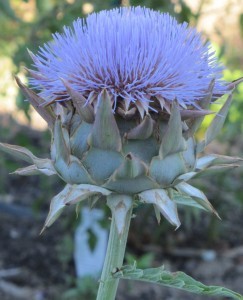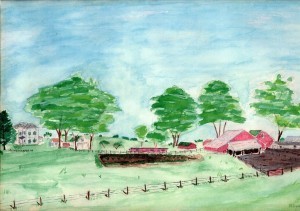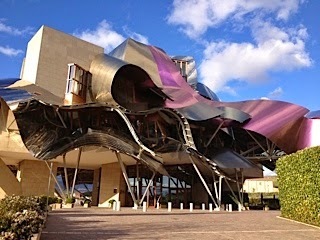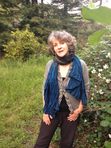Patricia Damery's Blog, page 16
August 1, 2014
Gratitude & the Great Turning: Five Things to Do
 A garden is a great place to prepare for the Great Turning. You can tell almost immediately how well it is being tended. In a tended garden, there is a feeling of peace, busy peace, perhaps, with bees and hummingbirds, monarchs and swallowtails, but also a calm contentedness that comes when the weeds are not competing for water and light, when the sun blesses tomatoes all day, and shade cools the brassicas by mid afternoon.
A garden is a great place to prepare for the Great Turning. You can tell almost immediately how well it is being tended. In a tended garden, there is a feeling of peace, busy peace, perhaps, with bees and hummingbirds, monarchs and swallowtails, but also a calm contentedness that comes when the weeds are not competing for water and light, when the sun blesses tomatoes all day, and shade cools the brassicas by mid afternoon.
I love letting things go to seed and reseed the next year, deciding for themselves who is going to make it and who isn’t. Our garden is the kind of garden that my husband said his German grandmother didn’t keep: tangled, exuberantly wild, yet yielding many onions, leeks, evening primroses and artichokes—and oh yes, valerian, which behaves as an invasive!
But I have come to value the conversation that happens when you really engage. Why is the zucchini vine yellowing within 10 inches of the root, and the melon vine’s leaves fold like wallets? When I have removed the (volunteer) nematode marigolds from shading the tomato plant and limited their offspring to a couple of dozen, the basil, tomatoes, and peppers grow faster and produce more. When I spend several minutes each morning checking moisture levels and hand watering the plants the irrigation doesn’t reach, gratitude comes— within myself, for sure, for I love seeing them thriving, but I also think from the plants as well.
As I water, I lift my eyes to the meadow beyond the garden fence, the meadow whose mystery includes picnic grounds for early white settlers and intimations of sacred rituals for centuries before that. This dreamy state of consciousness is a portal of the Great Turning, easy to enter in summer breezes, too easy to not have time for, and yet, critical to cultivate… and there are several things you can do to assist it:
1. Spend more time listening to the whisper of pine or the rustling of summer toughened oak leaves, or the chatter of cottonwood.
2. Water at least some of your garden by hand, waiting while the hummingbird, hovering at your hose-held hand, fights off the house finch for a drink.
3. Eat at least one thing a day that comes from the earth outside your kitchen door. (That is part of the dialogue, too!)
4. Meet an impossible animal and get to know it on its own terms.
5. Nap at least once a day and listen for any messengers who might contact you in that daytime twilight. They will fill you in on what to do next in this Turning.
The post Gratitude & the Great Turning: Five Things to Do appeared first on Patricia Damery.
July 4, 2014
Finding your Sense of Place: Snakes on Amazon!

A watercolor my father painted of the family farm, his own beloved sense of place that spawned me.
Find your sense of place again by reading Snakes! Leaping Goat Press has just released a second edition of my first novel Snakes, originally published in 2011 by il piccolo editions, Fisher King Press. It has a new cover described in an earlier post. As I have re-edited the book, I realize how much the writing of the story has formed my writing sense of self. When I began the novel, I had joined the writing group that I am in to this day, a group of women who not only mentored me as a writer, but an editor as well.
But the stories also wove my Jungian analyst interest in collective dreams, which these snake stories are, back into my relationship to the earth, and, eventually, to farming. These snake stories are really about relationship to earth, sense of place, and genius loci.
If you have not read Snakes, I invite you to now. For a short time I will send you a PDF for free in exchange for your willingness to post a review on Amazon, if you like it. If you don’t, write me!
Reviewer and Author Malcolm Campbell just blogged about the re-release. Visit him at http://sunsingerstravels.com. And explore his site! He is an entertaining, informative, generous blogger.
The post Finding your Sense of Place: Snakes on Amazon! appeared first on Patricia Damery.
June 3, 2014
June 9: Free Offer on Snakes: A Novel

In a week I will have pdf copies of newly soon-to-be republished Snakes (Leaping Goat Press, June 2014) and I am looking for people to read and then, if you like it, review the novel for Amazon (if you don’t, e-mail me instead!) Click on the link below, and on Monday, June 9, I will send you a pdf copy, or, if you prefer, I will have a few Advanced Review Copies. please use the link to e-mail your name and address.
Snakes is transformative story about love, farming, and myth’s place in it all. Weaver Angela struggles with life’s necessary everyday betrayals moving from Midwestern farm life to northern California, finding “new ground to stand on” through the bedrock of snake lore.
The title of the book, Snakes, reflects real life stories and the mythologies underlying them. The novel is studded with these stories, which also provide a frame for the larger story. Each chapter begins with a quote, usually from a snake manual, often presenting the reader with facts which are the fertile ground from which mythologies grew. The snake as life force prevails in the end as Angela’s relationship to the serpent moves from terror to acceptance of the energy of the Great Primordial Boa.
What is being said about Snakes:
It’s rare to find fiction that combines such alive characters with imagery that is so poetic.
—Adam Frey, Writer and Arts Administrator
Patricia Damery’s protagonist in Snakes speaks in a compelling, fresh, and immediate voice. From the first page, I was taken in by the powerful, precise language and cinematic action. The woman weaves snake stories and lore together with the threads of her life, forming a tapestry layered with knowledge of love, pain, joy, passion, and loss. Her feminine initiation, embedded in the rhythms of farming, engages her identity as daughter, wife, and mother, and delves into layers of the soul.
—Virginia Beane Rutter, Jungian analyst, author of Woman Changing Woman, Celebrating Girls, Embracing Persephone
Perhaps it is the skill required by the high craft of weaving that allows Damery to write multi-metaphorically, or the sheer simplicity of her storytelling. The straightforward language and structure can support the artistry of numerous images, which interlock and reinforce each other in a way I’ve not often seen.
So what is Snakes about? It is about the Risks we take, both major and minor, that coalesce over time to define our lives. It is about the Fear of the little things and Fear of the big things, and at the end of the day, the month, the season, and our lives, finding out that it was a shorter distance to Love than we thought. It’s about Mistakes and Regrets, and how necessary they both are to a life well and fully lived. It’s about the Earth and the Sea; the Individual and the Familial; Respect and Trust; Youth and Age. But most of all, Snakes is about finding one’s place in the Universe and how that journey is formed.
—New Mystics, Joey Madia, author of Jester-Knight, Amazon review
Click here to get your free copy for review!
Subscribe to my Newsletter
The post June 9: Free Offer on Snakes: A Novel appeared first on Patricia Damery.
May 26, 2014
Announcement: Snakes soon to be republished!

Publication Date: June 15
Leaping Goat Press
Snakes: a Novel began the first evening I met with the writing group of women which still meets every month these 30 years later. We had a exercise in which we were to talk with an inner critic. In my mind’s eye, a giant serpent came and told me to concentrate only on describing the patterns on her body. I began writing all the snake stories that I had ever heard as a child growing up on a small farm in the Midwest. The snake stories are true; the storyline developed as the protagonist Angela struggled with her relationship to her family and with her disturbed relationship to the land after moving from small farm life to study marine biology in California.
The snake is the medium, a symbol of psyche and earth; that first inner serpent is so like the snake on the new cover of Snakes (by Matt Hinrichs)!
Tell me what you think about the cover! I will be having a special offer in the next two weeks as Snakes is republished and relaunched by Leaping Goat Press and I would like your help. Watch for details!
The post Announcement: Snakes soon to be republished! appeared first on Patricia Damery.
May 21, 2014
Distillation and Death

Greener Pastures
Our goat Estrella passed at the end of bloom when the young grapes were bebe-sized, just before the Mariposa tulips popped into appearance. I told the vet that Estrella had to have help arriving, born by Cesarean, and that now she had to have help leaving. She was in too much distress; it was clear a catastrophic event was in process.
She was a small goat and she lay trustingly on my lap. Grief was thick as the vet calmly examined her, explained the procedure, and administered the poison that would move Estrella from this world into the next. We then laid her in the straw and the goats came one by one, saying goodbye. Anna, born two days before her 12 years ago, stayed with her for some time. For several days I felt the vacuum. It has lightened enough for me to write.
Estrella and her brother Libra were born in the early hours of my birthday. Her mother Natalie’s labor had stopped as Donald and I rushed her to the vet’s office as she watched traffic, a tiny, white goat leg sticking out of her. I always felt a special connection with Estrella. Children made her ridge rise. She didn’t like strangers; she loved being petted by those adults she knew.
I wonder how many animals die everyday on our ranch, food for something else? They go unmourned. What is it about those we mourn? What does mourning signify? Is there a consciousness-building involved? After all, the evolution of consciousness and of religion is connected to rituals around death.
Alchemical distillations pictures come to mind. There are series in various alchemical manuscripts where a dove dives up and down, over and over, for pages even, and slowly something forms. The De summa manuscript (Bibliotheque de l’Arsenal, Paris) is one example. Throughout the various operations “the eternal process of transmigration or sublimation is symbolized by the flight of the dove upwards and downwards.” In the end is the “exaltation of the Quintessence.”
From The Secret Art of Alchemy, by Stanislas Llossowski De Rola
Primo Levi said that the difference in distillation in chemistry and in alchemy is that in chemistry one is working for the pure substance. In alchemy, once the pure substance is separated, that the impure is put back in and the process repeated. The object is not purity but training matter in the process (The Periodic Table).
I have come to think of the cycles of death and rebirth in this way as well, whether that be in our everyday lives of things falling apart and then being redone, or in the larger cycle of birth and death and birth and death, on and on. Perhaps that is Estrella’s parting gift to me: this rethinking of the distillation of life and resulting the formation of the stone of the human soul. Mourning sharpens our attention to it.
The post Distillation and Death appeared first on Patricia Damery.
April 29, 2014
Healing and Archetypes

Marqués de Riscal Hotel
This last Sunday the Curriculum Committee of the C. G. Jung Institute of San Francisco offered an intramural event for members and candidates on Contemporary Issues in Archetypal Theory in which several members and board members presented different perspectives. The concept of “archetype” is an ancient one with roots as far back as Pythagorus, Plato and Aristotle. Goethe took up the concept again in the late 1700’s and 1800’s, which greatly influenced Carl Jung in the 20th century.
My thoughts were nourished by these presentations and discussions, which also reminded me of an experience of last April 2013. My husband Donald and I visited the Bilbao Guggenheim Museum, Spain, drawn mainly by its fame. The structure was designed by Canadian-American architect Frank Gehry and first opened in October 1997. Its photographs do not do it justice. Neither Donald, an architect himself, nor I expected to be particularly impressed. Nevertheless, we decided to visit such an acclaimed architectural feat and to splurge the night before by staying in another Gehry designed building, Marqués de Riscal Hotel, in the nearby village of Elciego.
Upon arriving at the hotel, we realized that we were in for an experience beyond anything we expected. The photos of the hotel give an impression of a building that looks like a wad of paper. In person, though, the space is transformative. One cannot assume anything about what is going to be experienced next. Our gently angular room was in the front of the hotel overlooking the entry, with a large wall of windows opening toward the vineyards and village nearly. In the morning we awoke to the sun rising into our sheltered space, the curve of the roof feeling very much like that of an egg. One was hatched into the new day!
The museum was a public expression of this experience. What I thought would be silly, in fact, stretched my imagination with potentialities. Through these structures, we accessed essence of space, the archetypal rendering of what contains and shapes us. I wonder, if in ripping away the common assumptions about what living and/or public space is, we experience something much more prime, and, as a result, we are renewed. Isn’t that what healing is? Being reconnected with the gods, in this case, the gods of space?
I suspect this is what happens in analysis. When it goes well, we do not enact archetypal processes, such as mother/child, or father/child, but actually hold the space in which these feelings and often unconscious complexes stemming from archetypal processes, visit the analytic container consciously. Through this, they are rendered to their essence and transform. What we experience is in fact a process, if we take Goethe at his word. If we are to know the essence of something, Goethe says, we must hold all aspects of it at the same time. Then we may know the Spirit of it. This is true if we are talking about the essence of a plant or the essence of a human being.
Is healing ourselves or our relationships with each other, or the earth, about reconnection with Spirit? What is your own experience?
The post Healing and Archetypes appeared first on Patricia Damery.



